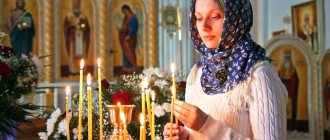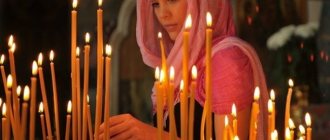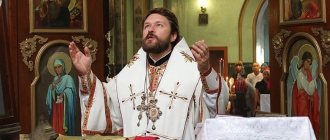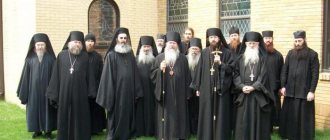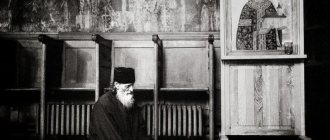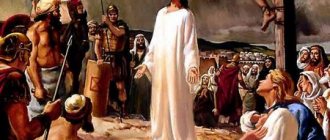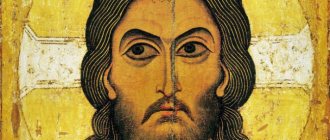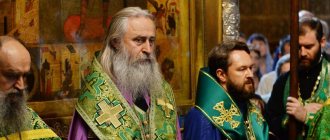What is a requirement and why is it needed?
First, let's understand the concepts.
As you might guess, demand is an action performed at the request of a person. In church meaning, the word acquired the meaning of a believer’s request to a priest to perform a sacrament or prayer according to need.
The priest has God-given grace and is a servant of the Lord, that is, a person who devotes his entire life to faith and its works.
The main task of the priest is to pray. And also to perform the sacraments, through which believers are given the Gifts of the Holy Spirit, necessary for the full life of a Christian, giving strength, spiritual and physical health.
For example, one of the common requirements is a prayer for health . In it, the believer, naming the name of the sick person, asks the priest to pray with him to God for the health of the person affected by the illness. As the Gospel, the foundational book of Christianity, says, “Where two or three are gathered in My name, there I am in the midst of them” (Matthew 18:20). It happens that a variety of everyday requests are addressed to God:
- for help in passing the exam,
- successful marriage,
- employment,
- safe journey.
And in these cases, the believer can call on the priest to pray to God together - by ordering a prayer. A priest can also be asked to perform the sacraments privately. For example, the wedding of a young married couple or the baptism of a child, and even confession and communion of a weak and sick person at home. Below we will take a closer look at the requirements and their types, and most importantly, their meaning for the believer.
Funeral service
God gives a person a limited time to live; in addition, unfortunately, it happens that the cause of physical death is tragedy. Christians believe that only a person's body dies, but his soul is immortal. Therefore, death is considered only as a temporary state until the general resurrection of the dead.
A funeral service is an action performed by a priest in which the deceased is prayerfully escorted into eternal life and asks God for forgiveness of sins and peace in the Kingdom of Heaven. The funeral service is popularly called the service because most of the prayers are sung.
This rite is performed on the third day after death (on the day of the funeral), the coffin is brought to the temple and over it the priest reads prayers, the Apostle and the Gospel, and the choir sings stichera and the canon. The coffin with the deceased remains open until the end of the funeral service; at the end of the prayer sequence, all relatives approach the coffin and say goodbye to the deceased. All prayers of the ritual are useful not only to the deceased, but also to living people, since they remind of the frailty of the world. We must remember that the Church performs funeral services only for baptized people. Funeral services are not performed for suicides, except in cases where it was committed in a state of insanity.
What is a registered note?
In some churches, in addition to the usual notes of health and repose, they accept customized ones.
notes.
A customized mass for health with a prayer
differs from a regular commemoration for health in that, in addition to removing a particle from the prosphora (which happens during a regular commemoration), the deacon publicly reads the names of those commemorated in the litanies, and then these names are repeated by the priest before the altar.
But even this is not the end of the commemoration according to the ordered note - after the end of the liturgy, a prayer is offered for them at a prayer service. The same thing happens at a custom-made mass of repose with a memorial service
- and here, after removing the particles with the names of the deceased, the deacon publicly pronounces their names at the litany, then the names are repeated in front of the altar by the clergyman, and then the deceased are remembered at the memorial service, which takes place after the end of the liturgy .
Sorokoust
is a prayer service that is performed by the Church daily for forty days.
Every day during this period, particles are removed from the prosphora. “Sorokousts,” writes St. Simeon of Thessaloniki, - are performed in remembrance of the Ascension of the Lord, which happened on the fortieth day after the resurrection, - and with the purpose that he (the deceased), having risen from the grave, ascended to the meeting
(that is, towards -
ed.
).
Judge, he was caught up into the clouds, and so he was always with the Lord.” Sorokousts are ordered not only for repose, but also for health, especially for seriously ill people. A prayer service
is a special divine service in which they ask the Lord, the Mother of God, and the saints to send mercy or thank God for receiving benefits.
In the church, prayer services are performed before and after the liturgy, as well as after Matins and Vespers. Public
prayer services are performed on temple holidays, on New Year's, before the start of the youth's teaching, during natural disasters, during invasions of foreigners, during epidemics, during rainlessness, etc. Other prayer services belong to private worship and are performed at the requests and needs of individual believers.
Often during these prayers there is a small blessing of water. The note for the prayer service begins with an indication of which saint the prayer service is being offered, whether it is for health or repose. Then the names of those for whom the prayer song will be offered are listed. When you submit a note for the prayer service, tell the minister whether you are ordering a water-blessing prayer service - in this case, a small blessing of water is performed, which is then distributed to the believers - or a regular one, without the blessing of water. You can order commemoration of the living or deceased for a month
, for
six months
, for
a year
.
Some churches and monasteries accept notes for eternal
remembrance. If you submitted a registered note, then the names written in the notes are pronounced at prayer shortly after the reading of the Gospel. At the end of the Gospel, a special (that is, intensified) litany begins - a general cry to God, a threefold “Lord, have mercy!” The deacon calls: “Recite (that is, let’s say, let’s pray, speak) with all our hearts, and with all our thoughts recit!” In two petitions, we strenuously ask the Lord to hear our prayer and have mercy on us: “Lord, Almighty, God of our fathers, pray (that is, pray to You), hear and have mercy. “Have mercy on us, O God...” All those in the church ask for the Patriarch, for the bishop, for the priestly brotherhood (a church parable) and for all “our brethren in Christ,” for the authorities and the army... The Church prays for mercy (so that the Lord will have mercy on us ), about life, peace, health, salvation, visitation (that is, so that the Lord would visit and not leave with his mercies), forgiveness, forgiveness of sins of the servants of God to the brethren of this holy temple. In the last petition of the special litany, the deacon strongly calls for prayer for those who bear fruit and do good in this holy and all-honorable temple, those who work (for the temple), those who sing and those who stand before them, expecting great and rich mercies from God. Those who bear fruit and do good are believers who bring to the temple everything necessary for Divine services (oil, incense, prosphora, etc.), who sacrifice money and things for the splendor of the temple and for the maintenance of those who work in it. On certain days, the special litany is followed by a special litany for the dead, in which we pray for all our departed fathers and brothers, asking Christ, the immortal King and our God, to forgive them all their sins, voluntary and involuntary, to rest them in the villages of the righteous and, recognizing, that there is no person who has not sinned in his life, we beg the Lord to grant our departed the Kingdom of Heaven, where all the righteous rest. During the litanies, the deacon pronounces the names of those indicated in the registered note and invokes God’s blessing on them, and the priest reads prayers. Then the priest says a prayer before the Throne, loudly calling out the names from the notes. The custom of reading notes with names during special litanies dates back to ancient, apostolic times - “the deacon commemorates diptychs, that is, the memorial of the departed.” Diptychs are two tablets made of paper or parchment, folded like the tablets of Moses. On one of them the names of the living were written for reading during the sacred rite, on the other - the names of the deceased.
Memorial service for repose and lithium.
On the 3rd, 9th, 40th days after death, as well as on birthdays and name days, the anniversary of death, memorial services, special services of the Church are held, at which they pray for the repose of their souls.
In addition, there are also Parental Saturdays, established by the Church as days of special remembrance of all deceased Orthodox Christians. The souls of the departed, awaiting the Last Judgment in the afterlife, require prayer support, because they themselves can no longer pray. The prayers of the living bring unprecedented joy to their souls.
A memorial service can take place both in a church and at the grave of the deceased. A short version of the memorial service is called litia. As a rule, it is to perform this prayer sequence that a clergyman is invited to the grave of the deceased.
Consecration of the home
During the consecration of a house, the priest applies an image of a cross to the walls of the house (usually these are special stickers), and sprinkles the walls with water.
God's grace is called upon the people living in the house.
It is important to remember that a person himself must pray to God, strive to change his lifestyle for the better, only then will the Spirit of God dwell in a person’s home. Before inviting a priest into your home, it is very important to put things in order, explain to everyone in the family the meaning of what is happening and behave as you would behave at a service. The family is called the “small Church,” and housing can also be called the “small temple” of a person. The consecration of the house is carried out once in a lifetime; in the future, the owner himself, with the prayer “Protect me, Lord, by the power of Your Honest and Life-giving Cross, and save me from all evil,” sprinkles the walls of the house with holy water and fumigates them with incense using a hand censer (katsey). .
Blessing of the vehicle
Often believers ask to consecrate their car, called a “chariot” in the rite of consecration. A vehicle becomes an indispensable companion in a person’s life, thanks to it he moves in space, transports cargo, and earns a living.
Of course, it is important that God's grace be invoked on this significant instrument. But it is also applied to the owner, who makes a promise that he will not do anything bad or ungodly while driving.
Sorokoust.
This is a prayer service that is performed by the Orthodox Church for an Orthodox Christian for forty days. It is served at the Divine Liturgy both for the living (forty feast for health) and for the dead (forty feast for repose). In the Orthodox tradition, magpie is considered a powerful service that helps to cope with many difficulties by the Grace of God.
The sacraments of baptism and weddings are also performed in the temple.
First steps in the temple. About commemoration
| Photo: V. Kornyushin / Pravoslavie.Ru |
The Church makes the main prayer for the health of the living and the repose of deceased Orthodox Christians at the Divine Liturgy, offering a bloodless sacrifice to God for them.
To do this, before the start of the liturgy (or the night before), you should submit notes to the church with their names (only baptized, Orthodox Christians can be entered). At the proskomedia, particles will be taken out of the prosphoras for their health or for their repose, and at the end of the liturgy they will be lowered into the holy chalice and washed with the Blood of the Son of God as a sign of Christ’s washing away human sins. Let us remember that commemoration at the Divine Liturgy is the greatest benefit for those who are dear to us. An eight-pointed Orthodox cross is usually placed at the top of the note. Then the type of commemoration is indicated: “On health” or “On repose”, after which the names of those commemorated in the genitive case are written in large, legible handwriting (to answer the question “who?”), with clergy and monastics mentioned first, indicating the rank and degree of monasticism (for example , Metropolitan John, Schema-Hegumen Savva, Archpriest Alexander, nuns Rachel, Andrey, Nina).
All names must be given in church spelling (for example, Tatiana, Alexy) and in full (Mikhail, Lyubov, and not Misha, Lyuba).
The number of names on the note does not matter; you just need to take into account that the priest has the opportunity to read not very long notes more carefully. Therefore, it is better to submit several notes if you want to remember many of your loved ones.
By submitting notes, the parishioner makes a donation for the needs of the monastery or temple. To avoid embarrassment, please remember that the difference in prices (registered or plain notes) only reflects the difference in the amount of the donation. Also, do not be embarrassed if you did not hear the names of your relatives mentioned in the litany. As mentioned above, the main commemoration takes place at the proskomedia when removing particles from the prosphora. During the health and funeral litany, you can take out your memorial and pray for your loved ones.
Regarding additional information about the person mentioned in the note, the following must be said. The only thing the priest performing proskomedia needs to know is the name of the Christian given to him at baptism or (for monks) at tonsure, as well as the holy order or degree of monasticism, if any.
Many, however, indicate in their notes before the names some information about the age, rank or position of their relatives, for example, ml. (baby, that is, a child under 7 years old), neg. (adolescent or young woman - up to 14 years old), c. (warrior), bol. (sick, painful), concl. (prisoner, prisoner), put. (travelling, traveling), ub. (killed, killed).
The Orthodox Church does not welcome such a custom, but does not forbid following it. Last names, patronymics, worldly ranks and titles, and degrees of relationship are not indicated in the notes. You should not write “suffering”, “embarrassed”, “needy”, “lost”. In the notes “On Repose” the deceased is referred to as “newly deceased” within forty days after his death.
In addition to general services (liturgy, vespers, matins), in the Orthodox Church there are private services called services (since they are performed upon request, by order of parishioners), including a prayer service (for the living) and a memorial service (for the dead). They are usually performed at the end of the liturgy and are ordered in the same place where they accept notes and sell candles.
A prayer service can be ordered for the Savior (thanksgiving, for the sick, for those traveling, etc.), the Mother of God (for Her various icons) or revered saints - at the request of the parishioner.
God is pleased that we receive help from Him in our needs through prayers to the Mother of God and the saints. So, for example, prayers before the icon of the Mother of God “Inexhaustible Chalice”, to the holy martyr Boniface, righteous John of Kronstadt help against the disease of drinking wine; St. Nicholas the Wonderworker is the patron saint of travelers, helps to marry off daughters, and generally quickly responds to various requests for help; holy warriors Theodore Stratilates, John the Warrior, noble prince Alexander Nevsky and others, as well as John the Baptist, patronize Orthodox warriors; in illnesses we resort for help to the great martyr and healer Panteleimon, the holy unmercenary doctors Cosmas and Damian; the name of many icons of the Mother of God (for example, “Joy of All Who Sorrow”, “Helper of Sinners”, “Softening of Evil Hearts”, “Mammal”, “Merciful”, “Quick to Hear”, “Healer”, “Burning Bush”, “Recovery of the Lost”) ", "Unexpected Joy", "Quench my sorrows", "Look at humility") says that She is our zealous Intercessor before God in various needs.
At the end of the prayer service, the priest usually consecrates the icons and crosses, sprinkling them with holy water and reading a prayer.
The memorial service is served before the eve - a special table with an image of the crucifixion and rows of candlesticks. Here you can leave an offering for the needs of the temple in memory of deceased loved ones.
Notes for a prayer service or memorial service are formatted as follows: the type of note is indicated at the top (for example, “Prayer of thanksgiving to the Savior,” “Prayer to the Vladimir Icon of the Mother of God for health,” “Requiem service”), and then the names are written in the usual order.
In many monasteries there is a special requirement - the commemoration of the living and the dead during the reading of the Psalter (this is an ancient Orthodox custom).
Monasteries and churches accept notes to commemorate living and deceased Christians for 40 days (Sorokoust), for six months and for a year. In this case, the names are recorded in the funeral synodik and the brethren of the monastery or temple during the specified period during each service pray for our relatives.
Realizing that the most we can do for our loved ones (especially the deceased) is to submit a note of remembrance at the liturgy, we should not forget to pray for them at home and perform acts of mercy.
